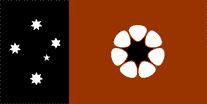
Bush Life in Kimberley, WA
Uranium exploration camp in 1972-73
Cat: MIS
Pub: 1973
#: 9006a
Kanzo
Kobayashi
90131u/18206r
Summary
要約
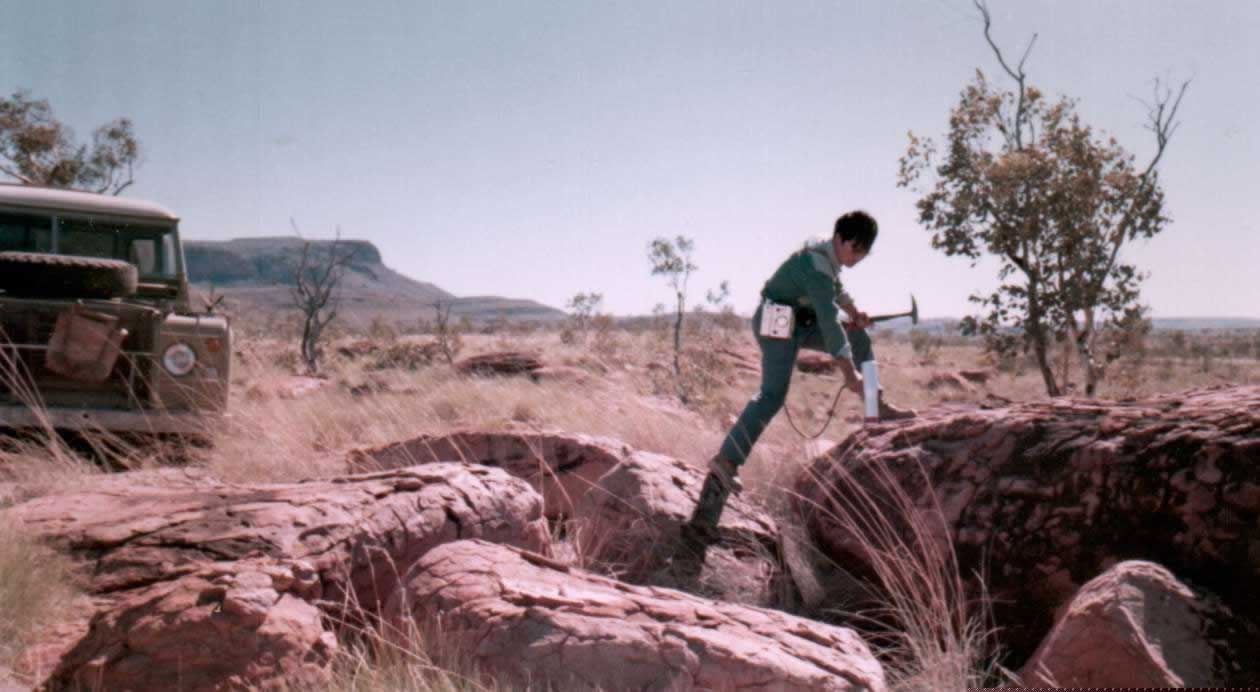
0. Australia - 1972:
- Can a human being returns to the past? I was sent from Itochu
to Uranium resources exploration project in Australia about two
years from 1972 as the only one Japanese geologist, joining to Agip
Nucleare Australia Pty Ltd, a subsidiary of AGIP of Italy. Then
there was neither PC nor Internet medium. I sent reports to Tokyo
from Australian field site, but no copies remain anymore. I hoped
to leave some records and memories about my very unique experience
as an engineer of Shogoshosha.
- The year 1973 became unforgettable for me; I married this year
and sent many letters to my fiancee or wife. Rereading bundle of
letters, various impressive scenes revived to me.
- These are the mineral exploration site reports from Kimberley
area, Western Australia in 1972-73 and a fragment about great nature
of Australia and bush life as well as some selected photos.
- The bush life in the dry continent of Australia was my starting
point as a businessman and discovery of wild nature and human life
working there; Let's flash back to the reddish continent still reserving
incredibly tough and unique fauna and flora, and challenging spirits
by multinational men to open their way. Here is several snapshots
keeping Lucky country, as Australia is sometimes called, which is
always waiting there for our rechallenge.
- What is the charm of Australia? It can be explained by quark theory;
it is composed of up, down, charm, strange, top and bottom:
- Regarding to up and down,
there is decisive difference between northern hemisphere and
southern hemisphere. Sun rises from the east, but goes round
northern side and sets west. Constellations and direction of
waxing and waning of the moon is different. Though there is
no difference between up and down in the universe, we northern
hemisphere habitant feel surprised.
- Regarding to charm and strange factors, every fauna and flora looks different. A beast jumps
and a bird runs. Marsupials stand top of the animals. In subtropical
savanna climate, ancient rocks of glacier age are widely distributed.
Colorful wild birds flying about look as unusual as birds in
the zoological cage. It is a continent full of strange nature
and full of charms.
- Regarding to top and bottom, kangaroo is a top-ranked animal, and even
defenseless koala is breeding, while in the bottom small animals
and insects are relatively bigger in size and living without
fear. Ants constructs big anthills, and colorful birds and insects
look fearless. Australia is a rather flatter continent which
teaches us a world of symbiosis and coexistence.
0. Australia -1972:
- 人間は過去へ戻ることができるのだろうか?私は伊藤忠商事より、1972年から約2年間豪州でのウラン資源開発のプロジェクトに、Geologistとして派遣され、イタリーのAGIPの豪州子会社であるAgip
Nucleare Australia Pty Ltd.に、唯一の日本人としての海外駐在員となった。当時は、パソコンもインターネットもなかった。豪州の現地からの記事も書いたが、もう原稿は残っていない。伊藤忠での最もユニークな経験をした者として、ぜひ当時のことを書き残したいと思っていた。
- 1973年当時は、私は結婚直前であったので、数多くの手紙をFianceeに書いた。その膨大な手紙の束を読み返すと当時の状況が眼前に広がってくる。当時の状況を思い出しつつ、1970年代初期の西オーストラリア北部のキンバレー地域での資源開発の現場の生活、そして豪州の大きな自然のごく一部を、何枚かの懐かしい写真とともに思い出してみたい。
- 乾燥した豪州大陸でのブッシュ・ライフは、私の社会人としての原点でもあり、この自然と人間を考える起点でもあった。あの赤い強烈な大陸、そして信じられないようなタフでユニークな植物や動物たち、その中で自然を切り開こうとする多国籍の男たち...今でも、豪州の大陸は、タイムマシンに乗って訪れることができるラッキー・カントリーなのだ。
- ところで「豪州の魅力とかけてクォーク理論」と説く。その心は、アップ・ダウン・チャーム・ストレンジ・トップ・ボトムの特徴を備えているからである。
- アップ・ダウンから言えば、南半球ゆえの北半球との違いがある。太陽は東から昇るが北側を回って西に沈む。星座も異なるし、月の満ち欠けも異なる。宇宙の上下関係はないはずとはいいながら、北半球の習慣になれた者からみるとアップサイドダウンに見える。
- チャーム・ストレンジについては、あらゆる動植物が他の大陸と異なる。獣は跳び、鳥は走る。有袋類が動物の中では一番頂点にいる。植物は異なっている。現在はサバンナ気候の猛暑の中に、なぜか大昔の氷河時代の岩石が分布する。動物園の檻の中の鳥とその辺で飛び回っている野鳥は、同じように派手派手で珍しい鳥に見える。ともかくストレンジな大陸であり、だからこそチャーム一杯なのだ。
- トップ・ボトムについては、一番強い動物はカンガルーであり、コアラのような無防備な生き物も繁殖している。一方ボトムに属する昆虫や小動物はサイズも大きく、恐れずに生きている。アリ塚は巨大な巣を築いているし、鳥も昆虫も色鮮やかで人を恐れることを知らない。豪州は、生き物の共生と共存を教えてくれるよりフラットな大陸でもある。
>Top 1. Joint uranium
exploration works in Australia:
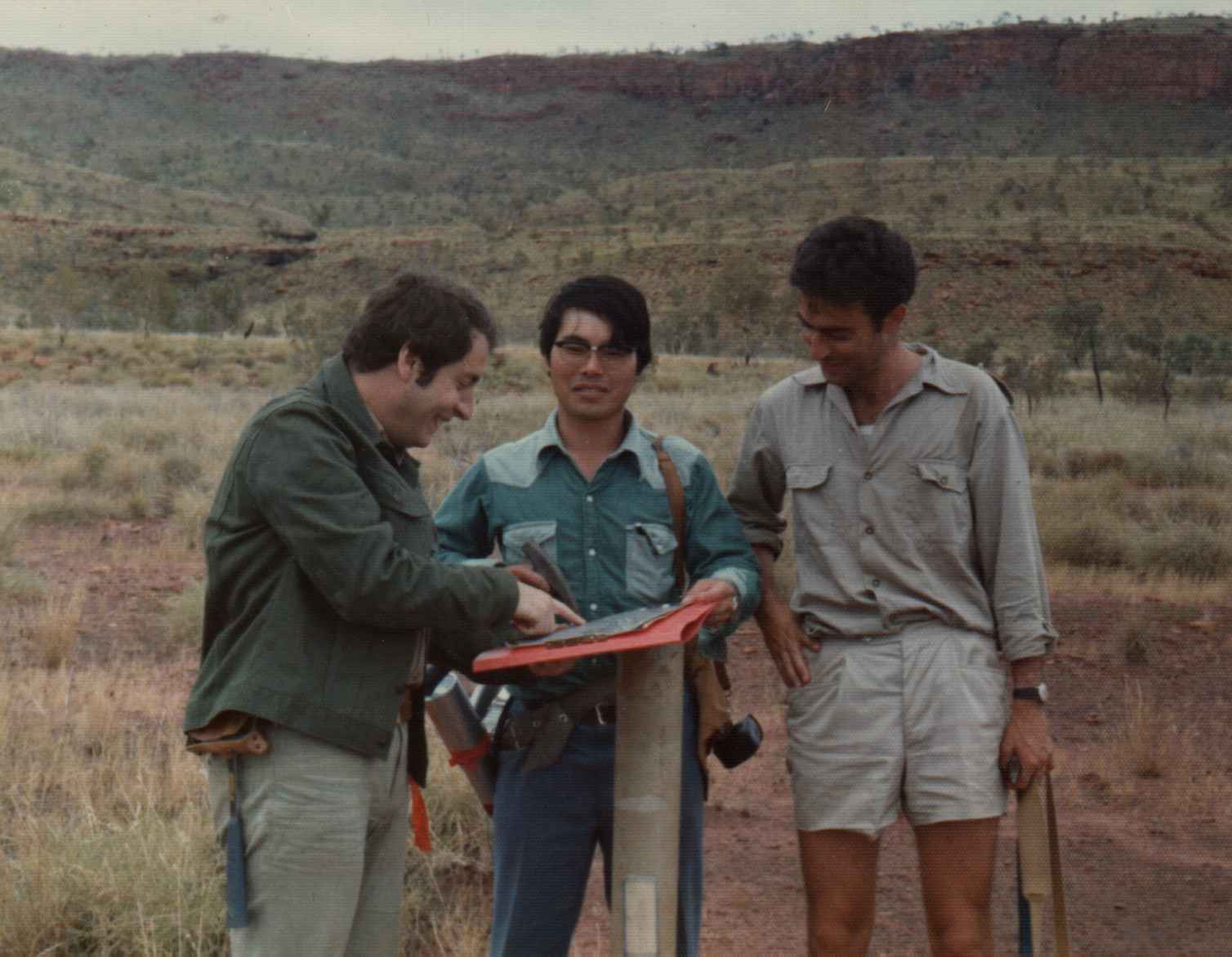 Nuclear fuels for power reactors only exist in the limited areas
in the world. Northern part of Australia covered by Precambrian
old rocks is one of such promising areas of uranium oxide. Since
early 1970s advanced countries competed to join in exploration activities
in this area to secure stable energy resource. Itochu corporation
was one of them, organizing joint venture with Italian ENI (Ente
Nazionale Idrocarburi) group to promote joint mineral exploration
activity in Australia.
Nuclear fuels for power reactors only exist in the limited areas
in the world. Northern part of Australia covered by Precambrian
old rocks is one of such promising areas of uranium oxide. Since
early 1970s advanced countries competed to join in exploration activities
in this area to secure stable energy resource. Itochu corporation
was one of them, organizing joint venture with Italian ENI (Ente
Nazionale Idrocarburi) group to promote joint mineral exploration
activity in Australia.
- I was sent from Itochu to participate such big project for two
years from 1972 through 73 to Agip Nucleare Australia Pty Ltd.,
an Australian subsidiary of AGIP. I joined Itochu in 1970, having
just two years experience there, neither enough training in English
literacy, nor local knowledge and human connection, but I had no
options to escape; only jumping into the project with uncertainty,
expectation and curiosity.
- I believe I still keep No.1 record in all Itochu (including Australian
staff of Itochu offices) of such experiences; 1) most widely traveled
by Landrover in Australia, 2) most frequently ridden on helicopter
for gamma ray survey, 3) most longest tackle with Australian rocks
in the field.
- I'd like to introduce several nature and bush life at Kimberley
area, Western Australia, which is almost unchangeable even now after
27 years.
- An article of Journal 'Weekly Diamond'
as of Aug. 3, including the top inserted photo says:
"Dependency of major resources to overseas countries, which
is indispensable for Japanese economy is increasing. Mineral resources
are no exceptions. It is true sogoshosha (trading companies) are
securing almost all necessary resources from overseas. Highly skilled
trading firm staff are wandering about worldwide possible areas
to find such necessary resources. Exploration work is very risky,
which explains why sogoshosha are keen in integrating information,
fund and organization to purchase high risk and high return projects.
They only believe it is their mission to perform at anywhere on
the earth."
1. 豪州ウラン共同探鉱に従事:
- 原子力発電用のウラン燃料は、世界に偏在している。先カンブリア紀の古い岩盤のある豪州北部は、世界でも有数なウラン資源の産地である。1970年代当初より、世界の先進国は、競ってこの地域に探鉱調査を開発して、自国のエネルギー資源の安定確保のために奔走した。伊藤忠商事もその中の1社で、イタリアのENIグループと組んで、共同探鉱を開始した。私は、1972年より約2年間、そのような大規模のプロジェクトに現地調査に参加しつつ日本側に情報を送るために、豪州の探鉱会社Agip
Nucelare Australia Pty Ltd. に海外出向することになった。当時は、入社2年目で、英語も土地勘も知識もなく不安と期待と好奇心一杯の駐在員であった。
- おそらく伊藤忠の中で (豪州店の豪州人スタッフを含めても) 、小生が、ランドローバーで最も広く豪州の原野を走破し、ヘリコプターに最も多く乗ってガンマー線で測定し、最も長い時間豪州の岩石と格闘したと信じている。
- 豪州27年経過した今でもほとんど変わりないであろうキンバレー地域の自然と生活を紹介したい。
- 週間ダイヤモンドの記:1974/8/3号: 冒頭の写真も掲載
『日本の発展にとって必要欠くべからざる重要資源の海外依存度は刻一刻高まっている。鉱物資源も例外ではない。..日本の海外資源開発の全部が総合商社のおかげといっても言い過ぎではない。高度な知識をもった商社マンが世界中を駆けめぐって有望な資源の発見の努めている。...資源開発は水ものの言われるが、それだからこそ総合商社の人、情報、資金、それを有効にオルガナイズし、システム化する力が求められるわけだが、それだけに危険性と背中合わせでビジネス面で難しさがある。それでも総合商社は黙々と使命を果たしていくのだ。』
>Top 2. Camp
at Kimberley - Sept. 26, 1972:
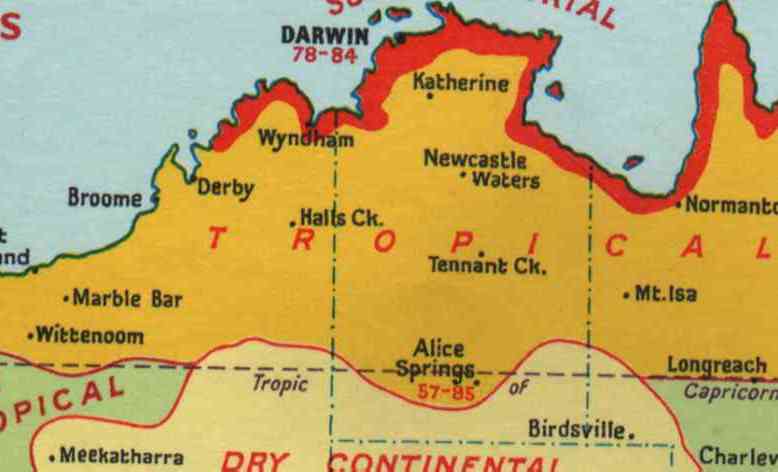 At 7:40 on Sept.23, 1972, we left Sydney, changing airplane three
times at Brisbane, Mt. Isa, and Darwin, and arrived at 'The Ord
River Motel at Kununura. The motel was equipped with pool, staying
there two nights. On Sept. 25, Land Cruiser came to the motel to
pick us up. It was about 220 miles driving from Kununura to Hall
Creek where is the nearest town from the camp site. 60 miles from
Hall Creek to the Camp site was extremely bad road. We arrived the
camp late at night, crossing many cattle farms with opening and
closed fences each time.
At 7:40 on Sept.23, 1972, we left Sydney, changing airplane three
times at Brisbane, Mt. Isa, and Darwin, and arrived at 'The Ord
River Motel at Kununura. The motel was equipped with pool, staying
there two nights. On Sept. 25, Land Cruiser came to the motel to
pick us up. It was about 220 miles driving from Kununura to Hall
Creek where is the nearest town from the camp site. 60 miles from
Hall Creek to the Camp site was extremely bad road. We arrived the
camp late at night, crossing many cattle farms with opening and
closed fences each time.
- The camp members are 2 chief geologists, 3 assistants, 1 cook,
each is allocated 10 sq.meter wide (107 sq.ft) tent, which contains
2 folding beds, 1 set of small camp desk and chair surrounded by
mosquito net. The temperature in daytime rose 27-28 degrees Celsius
(81-82F) but rather comfortable in the morning and the evening.
Birds sing very loudly. Two small wallaby kangaroos welcomed us
near the camp. Owing to electricity generated by oil, we can read
a book, use common refrigerator and shower. Water is precious and
no washing is allowed in the camp.
- Breakfast starts at 6:30, and our survey works start at 8:00.
Lunch is 11:00, finishing almost the day's job around 15:00, thereafter
we must consider how to spend lengthy evening and night. No TV,
but short wave radio is barely possible.
2. キンバレーのキャンプへ (7/26/1972)
- 9月23日の朝7:40にSydneyを出発し、Brisbane, Mt. Isa, Darwin, Kununuraと飛行機を3機乗り継いで、ようやくKununuraのThe
Ord River Motelに泊まった。Motelといっても、プールのあるなかなか立派なものだ。。そこで2泊した後、25日の昼過ぎにLand
Cruiserが迎えにきた。Kununuraからキャンプの近くのHalls Creekまでは約220マイルの快適なドライブだったが、そこからキャンプまでのわずか60マイルが大変な悪路。やって夜暗くなって到着した。途中、牧場を何回も横切り、牧場の柵を何回も開閉して通った。
- このキャンプにはチーフ・ジオロジストが2人、アシスタントが3人、コックが一人いる。ひとりづつ6畳ほどもある大きなテントを張って、中には簡易ベッドが2つ、他に小さなテーブルと椅子がある。周囲は蚊帳のようなネットが張ってあり虫の侵入を防ぐ。昼間は27ー8度C位でかなり暑いが、朝夕はしのぎやすい。鳥がうるさいほど鳴いている。子犬位のワラビーカンガルーが2匹現れた。キャンプはかなり電化されていて、夜、本も読めるし、冷蔵庫やシャワーもある。水が貴重なので洗濯機はない。
- 朝食は6時半、8時には行動開始。11時に昼食。午後3時にはもうほとんど仕事おしまい。この後、長い夜を過ごすことになる。テレビはないが、短波放送はやっと入る程度だ。
>Top 3. Halls
Creek: population of 200 - Oct. 11, 1972:
 It is Wednesday today. It is the day when the regular vehicle
goes to Halls Creek, the nearest town to buy foodstuff and to visit
the post office. I asked chief geologist of the camp to ride on
the vehicle to Halls creek to have telephone call to Tokyo. Almost
all day is spent for the telephone call. Halls Creek is a small
town with about 200 habitants located in the middle of Kimberley
area, northern part of Western Australia. I asked to a manager of
the post office how many times it takes to call to Tokyo. He replied
he has no experience to call to Tokyo. Many staff of the post office
cooperated for me to try to link to Tokyo.
It is Wednesday today. It is the day when the regular vehicle
goes to Halls Creek, the nearest town to buy foodstuff and to visit
the post office. I asked chief geologist of the camp to ride on
the vehicle to Halls creek to have telephone call to Tokyo. Almost
all day is spent for the telephone call. Halls Creek is a small
town with about 200 habitants located in the middle of Kimberley
area, northern part of Western Australia. I asked to a manager of
the post office how many times it takes to call to Tokyo. He replied
he has no experience to call to Tokyo. Many staff of the post office
cooperated for me to try to link to Tokyo.
- I wrote out a prize thesis sent to Itochu headquarter via Sydney
office with the title of "Three proposals for mineral resources;
policy, system and staff" posting from a hotel at Kununura.
This is a kind of advertising balloon that emphasizes the function
of joint mineral exploration project in Australia. I have no idea
how it will turn out.
- I heard there would be special program of TV about exploration
of mineral resources of Australia. Lots of big baggage with name
plates of worldwide mining companies like Kennecott Exploration,
BHP Exploration are arriving at the airport of such a small town.
Kimberley area will becoming a stimulative center of mineral exploration
activities focused by global companies.
- Sydney is a clean and mild climate city, but here Kimberley belongs
to tropical savanna climate, where outdoor camping is not comfortable.
It is a battle against scorching sun and flies In the daytime and
innumerable mosquitoes in the nighttime. However short times from
5:30 to 7:00 in the morning and 16:30 to 18:00 in the evening are
comfortable. I am spending the former times for waking up from dream,
and the latter for reading to train the frontal lobe. Conversation
with the camp fellow is also a good training for improving my English.
About six hours in the daytime are spent for concentration of geological
survey.
3. 人口200人のHalls
Creek (10/11/1972):
- 今日は水曜日。近くの (80マイル先の) Halls Creekへ定期便の車の出る日です。キャンプのチーフ・ジオロジストに、どうしても東京に電話をしたいからといって、その車に乗り込んだのです。今日の一日は、すべてあなたと5分間の電話をするために使われたようなきがします。と言っても、
(西豪州Kimberleyの真ん中にある) Halls Creekのは、人口は約200人位の小さな小さな町です。郵便局へ行って、東京へ電話をしたければ、どの位の時間と費用がかかるのかと聞いたら、そこの係りの人は東京へ電話をかけたことは今まで一度も経験がないそうです。結局、郵便局中の人が協力してくれて、一時間ほどで東京とつないでくれました。
- 社内懸賞論文「資源開発への3提言:ポリシィ、システム、スタッフ」の原稿がついに完成し、ここUninsurableのホテルから、Sydney経由東京本社に郵送しました。資源開発-この4文字については、現場にいる小生にお任せ下さいというアドバルーンを全社内に打ち上げたようなもの。さあ結果はどうなるか?
- 豪州の資源開発についてのテレビの特集番組があるらしい。こんな小さな町の飛行場の航空荷物受取所にもKennecott ExplorationやBHP
Explorationなど、世界の一流企業の名前のついて大きな荷物が届いている。Kimberleyにはそうした世界的な資源開発ブームの波が打ち寄せてきている地域の一つなのだと思い、緊張した。
- Sydneyは、気候も良いし町もきれいだが、ここKimberleyは、熱帯サバンナ気候に属し、野外キャンプでの生活は楽ではない。昼間は灼熱の太陽とハエ、夜は電灯に集まる無数の蚊との闘いだ。それでも朝5時半から7時までと、夕方4時半から6時までの短い時間はとても爽やかで気持ちがいい。前者はまどろみながら夢から覚めるために、後者は前頭葉を鍛えるために読書の時間にしています。キャンプの仲間と話すときは、すべて英会話実習の時間になる。そして昼間の6時間位は、地質調査に奔走する。
>Top 4. Holidays
at the camp - Oct. 12, 1972:
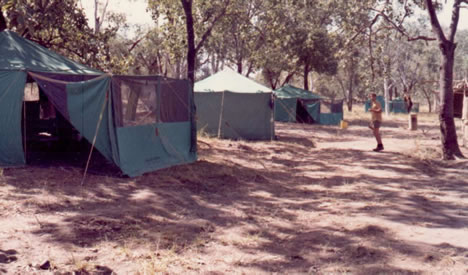 Tomorrow, a special liaison car is to leave for Halls Creek carrying
letters including this. We enjoyed mahjong this evening, the rule
here is much simpler, and they call mahjong tiles like "Five
Sticks", "Eight Balls", "Two Characters",
"Red Dragon", "Green Dragon", Square Dragon",
"East Wind, etc. I was surprised to be invited to join mahjong
play with them. When I taught them how to call in Chinese, They
were all enjoyed to hear it.
Tomorrow, a special liaison car is to leave for Halls Creek carrying
letters including this. We enjoyed mahjong this evening, the rule
here is much simpler, and they call mahjong tiles like "Five
Sticks", "Eight Balls", "Two Characters",
"Red Dragon", "Green Dragon", Square Dragon",
"East Wind, etc. I was surprised to be invited to join mahjong
play with them. When I taught them how to call in Chinese, They
were all enjoyed to hear it.
- In chess games at the camp, I was then one win and three defeats.
A cook from Poland is the strongest in the camp. Chess does not
allow reuse of the pieces of the enemy unlike Japanese Shogi,
but similar strategy is applicable in both games. In this way, time
passes by in a monotonous outdoor camp.
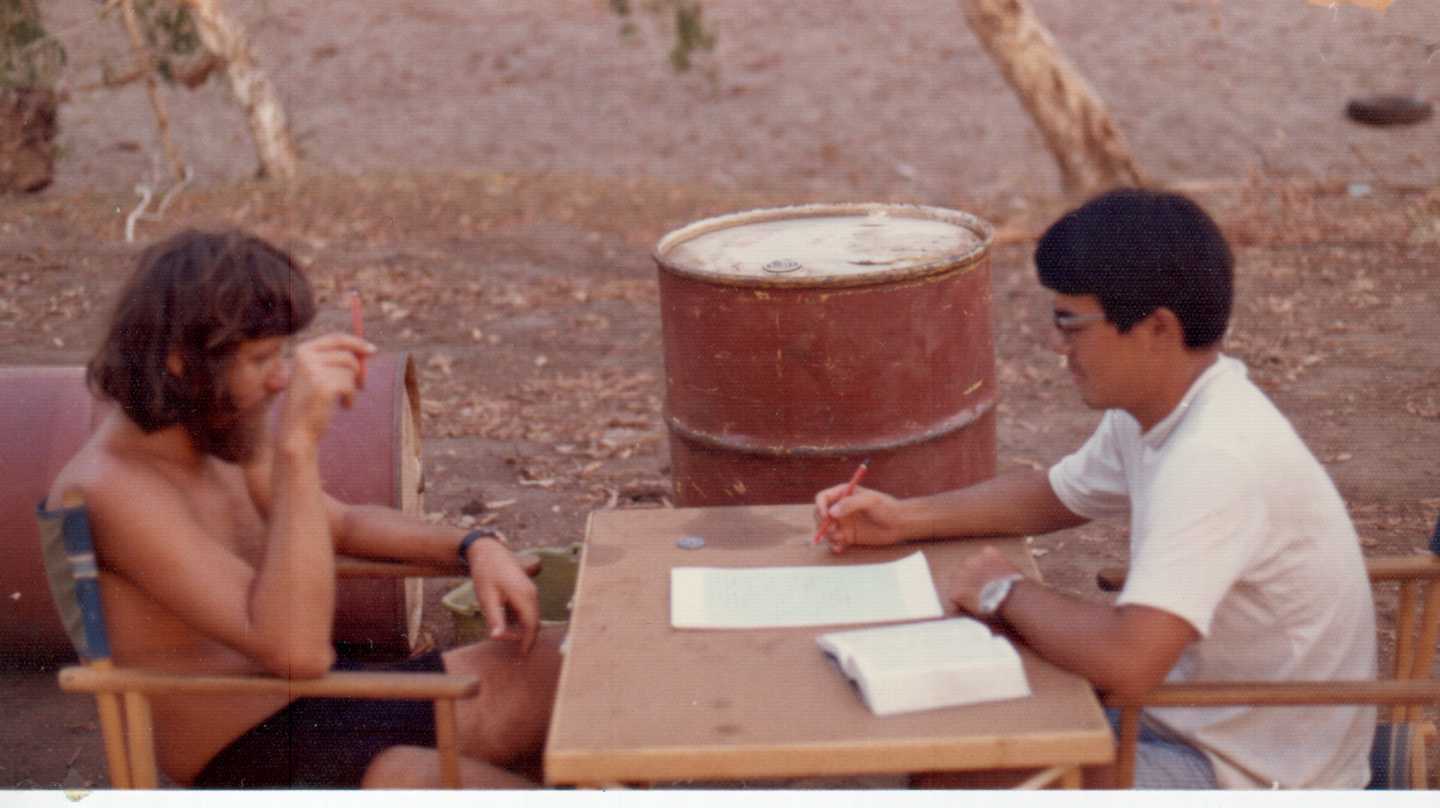
- A chopper (they call a helicopter like this) came from the next
camp two days ago. We can cross over at once steep valleys and gorges
with this chopper, bringing us much more efficiency in our geological
survey. I took several interesting photos from the chopper. Sky
views of mountains and valleys gives us instant understanding of
the total topography. Please imagine that we are freely flying in
the sky without any cloud. The pilot is a Korean trained at US army
and experienced one year at Vietnam war, but he declined from there
within one year. He is an interesting guy who comments absurdity
of the war caused by US.
- Next week Italian geologists are scheduled to join us. The camp
is getting more global; Australian, Polish, Korean, Italian, English
and Japanese. All speak English with different accent reflecting
each original tongue; Australian and English is the best and I am
the worst speaker.
- There is almost no time difference between Tokyo and here; but
actually a big difference of half a year. It is getting warmer from
now on.
- Some camp members have keen interest in Japanese culture. Teaching
Japanese in English is not so easy. At the beginning we talk each
other about self-introduction, experience and topics of interest,
then we talk about hobbies and hopes in future, etc. It is not easy
to explain and continue our conversation in English, otherwise silence
continues..... but seizing an opportunity we start to talk again.
It is important to participate in various themes of discussion.
- Here is a story about a toilet in the camp. There is no toilet
facility in the camp. There are several small scoops prepared with
toilet papers looped to the shaft. In case of necessity, each user
brings one of them and goes to some favorite places a little far
from the camp; someone in the dry river, others in shadow of trees.
In wet season all the buried things are flooded away; which will
be an ultimate recycle system. In my case, every morning I go to
the almost definite places with the scoop, digging a small hole
presumably different place from yesterday's judging from landscape
and direction of the sunrise. It is rather a philosophical time
for me being bathed by early morning sunshine, surrounded by birds'
singing and praying the day's safety.
4. キャンプの休日 (10/12/1972) :
- 明日、Halls Creekに連絡特別便が出ることになり、この手紙も投函できそうだ。今晩は、驚くなかれ麻雀をした。といってもルールは日本よりずっと簡単で、パイの呼び方もおもしろく、例えば、"Five
Sticks", "Eight Balls", "Two Characters",
"Red Dragon", "Green Dragon", "Square Dragon",
"East Wind"などと呼ぶ。それぞれ「五筒」「八ピン」「二萬」「中」「發」「白」「東」のこと。とにかく外人から麻雀をしようなんて言われて驚いた。中国語では、こう呼ぶのだと言ったら相手も驚いていた。
- チェスの成績は、目下1勝3敗。ポーランド出身のコックが、やたらチェスが強いのだ。日本の将棋と違って、駒をはることできないが、おなじような手筋が使える。こうして単調な野外キャンプ生活もどんどん時間が過ぎ去って行く。
- 2日前に隣のキャンプからヘリコプターがやって来た。険しい山道をヘリなら、一っ飛びだ。これからかなり地質調査は機動力を発揮してやっていける。空からおもしろい写真を撮った。山や谷の地形も空からだと手に取るようにわかる。雲一つない大空を自由に飛び回っていることを想像して下さい。パイロットは、アメリカで訓練された韓国人で、ベトナム戦争に参加したけれど1年でいやになってやめてきたといっている。あんなばかばかしい戦争は米国はやるべきでないといっているおもしろい韓国人だ。
- 来週にはイタリア人のジオロジストがやってきます。コックはポーランド人だから、結局、豪州、ポーランド、韓国、イタリア、英国、日本とますます国際的になってきました。皆英語を話すければ、それぞれのお国訛りがあっておもしろい。
(豪州・英国人が一番うまくて、小生が一番下手だが)
- 東京と豪州とはほとんど時差はなが、考えようによっては、半年も時差があるとも言える。こちらはこれから暑くなる一方で、太陽は東から昇って、北の方をぐるーと回って西へ沈む。太陽のある方向が南ではなく北なのだ。信じがたいが事実なのだ。豪州では、北側に広い庭を作るし、植物は北に向かって生い茂るし、年輪も北側がよく成長する。月の満ち欠けも反対で、三日月は左上側から満ちてくる。地平線近くにやっと見える北斗七星は、ひしゃくが下を向いていてとても水をすくえない形だ。それに豪州には、南が上になったさかさまの地図を売っている。宇宙空間には左右の差はあるが上下の差はないはずだから、さかさまとは必ずしも言えないと思う。
- キャンプの連中は、日本語に興味をもっている。英語で日本語を教えるのはなかなか難しい。人間なんて、長い時間一緒に生活していると、最初は珍しいから自己紹介とかとりとめもないことを話し合う。その内、趣味や将来のことなど話をするようになる。なかなかうまく説明できなくて、そのうち沈黙が続く...でも何かの機会に再び話し合いのきっかけがつかめる。いろいろなテーマに参加する姿勢が重要だ。
- 閑話休題:トイレの話
ところでCampにはトイレがない。柄の所にトイレットペーパーを刺した小さなスコップがいくつか準備してある。必要に応じて、それを持って水のない河原や木陰に歩いていって用事を足すのである。それぞれが好みのテリトリーをもっているようだ。雨期になるとすべて水に流れるので究極のリサイクルという訳だ。毎朝定刻になると小生も好みの場所に出かけて昨日と少し違う所に穴を掘る。いつも見慣れた木々と太陽の方向を推し量りながら場所決めをするという知的な作業となる。朝の日の光と鳥の鳴き声を聞きながら、一日の無事を祈り、しばし哲学的な思索の時を過ごすのである。
>Top 5. On
the billabong - Oct. 14, 1972:
- It is Saturday and no works today. Usually I get up at 6:00, but
slept until 7:00 today. We went to swim to a billabong near the
camp. This 'Billabong' is an aboriginal term, meaning a part of
the river with water remaining even during dry season, looked like
a pond. There are many fishes in the billabong, pecking us in the
legs or belly, perhaps with no fear of being fished or threatened.
After the swimming, barbecue lunch at the riverside begins, getting
the water from the same billabong where we swam. It is true that
the water with fish or even mosquito larva is safety, which proves
as poisonless as such creatures can survive.
- The camp life tends to be monotonous. In order to resist it, I
allocated the best period of time for reading, studying and writing;
from 16:00 - 18:00 after the work, from 20:00 - 21:00 after dinner,
and from 5:00 - 6:00 before dawn when I spent for dozing.
5. ビラボンのほとり (10/14/1972):
- 今日は土曜日で調査活動は休み。いつもは6時に起床だが、今日はゆっくりと7時まで寝た。今日は、Billabongへ水泳にいった。このBillabongとは、原住民の言葉で、乾期でも残っている川の一部で、沼のようになっている所のこと。魚が沢山いて、泳いでいると足や腹をつついてくる。きっと釣られたり脅かされた経験がない魚なのだろう。泳いだ後は、川辺でバーベキューの昼食となる。お茶を湧かす水も同じBillabongから取ってくる。ところで、魚やボウフラのいるビラボンの水は安心である。少なくとも生物が生きられる程度には毒が含まれていないからである。
- キャンプの生活はともすれば単調になりやすい。それに抵抗するために、読書・勉強・手紙書きに一日の内の最も良い時間帯にすることにした。仕事が終わって夕食までの4-6時、それから夕食後の8-9時の3時間だ。夜明前の5-6時も気持ちの良い時間帯だが、これはまどろみの時間とすることにした。
- Australians fellows began to play cards, while I enjoyed reading
alone in the shade of a tree, a book named "Adam in Ochre"
written by Colin Simpson, a researcher of Australian aboriginal.
Billabong is mentioned in the book, saying 'Billa' means 'river',
'bong' means 'dead'. The scene of the book is Arnhem Land in Northern
Territory, far north-east from here, where Aboriginal Reserve having
same area of Scotland is defined. Both climate here and there are
alike, and interesting description of the book tempted me into non-stop
reading 240 pages.
- Followings are quoted (original English
should be more poetic, because I read Japanese version.):
- "It was the most wonderful moment
in a day when the last glitter before sunset reflects on the
water, and wind becomes calm in the evening. I was standing
alone near a swamp where wind is blowing from summit of Yenyark,
and felt deepest comfort of soul and existence of spirit there.
Creatures sharing this stillness were only aboriginals and waterfowl
floating motionless on the water. I am also pursuing something
much greater than anything in cities where we live, and strong
emotion gradually filled my heart. How can we remind this unforgettable
moment? This feeling was common among all people participated
in the research....."
- There was another description;
"I stood at the edge of a cliff. There ware gray colored
rocks suffered tens of thousand years weathering scarcely balanced
on a table-shaped rock in a widely opened valley below. The
blade of sharp rocks like wafer was made by suddenly pulling
half way from the buried ground by the wind, or was sunk into
sea floor being eroded by wave unimaginably long time age, then
was returned and destroyed again on the surface. In ancient
times, sandstones were eroded, leaving gigantic weathered rock
pillars. Rain and wind finally changed big nature architecture
into gray and strange-shaped rocks of garden. This was the history
of Australian continent. Living creatures would not live between
such rocks. Event the wind-delivered seeds reluctantly buds
and leaf stunted here after battle with such severe nature.
Everything kept still in the valley. This was another world,
located at the boundary between living and dead world ..."
- 豪州人の連中は早速トランプを開始したが、小生は木陰で一人読書。「今日を生きる原始人」 (Adam in Ochre by Colin
Simpson) というオーストラリア原住民のことを書いた本である。Billabongのことはその本にも登場する。 (原住民の言葉で、Billaとは「川」、bongとは「死んだ」という意味で、死んだ川を意味する。)
この本の舞台は、このKimberleyよりもずっと北東のNT準州のArnhem Landというほぼスコットランドに匹敵する面積をもつAboriginal
Reserve (原住民保護区) だが、気候的には似ている所も多く、また記述がおもしろくて240ページを一気に読破した。
- その一節...
『太陽の日没前の最後の輝きが水面に映り、風が途絶える夕べのひとときは、一日中で最もすばらしい時間であった。インヤルクの頂が風を落とす沼のほとりに一人立った私は、全身にしみ入る深い魂の慰めと霊的なものの存在を感じていた。この静けさを分け合っている生き物は、離れた所にいる原住民と水面に身動きもしない水鳥だけでった。都会に住む我々が追求しているものの何にも増して偉大なものを、今私もまたここで追求しているのだ。大きな感激が胸の底からじわじわと湧きあがってくるのだった。この一瞬をどんなに懐かしく思い出すことだろう。それは、参加したすべての人が抱いた感慨であった。...』
- また次の一節。
『私は断崖の縁に立った。眼下に開けた谷間には、幾万年の歳月を深く染め付けた灰色の岩が、辛うじてバランスを保ちながら岩のテーブルにのっていた。ウエハースのように薄く鋭利な岩の刃は、風の紙の軽い指先が、斜めに突き刺さった地面から半ば引っ張り上げたようであった。
あるものは、我々の想像も及ばない昔に海の底に引きずりこまれて波にもてあそばされたあげく、突然地上に返されてぼろぼろに崩されていた。太古の昔には、砂岩が浸食され、巨大の岩の柱となった空を圧してそびえていたであろう。雨と風とは、自然の大建造物を灰色の奇岩の庭に変貌させたのである。これこそ豪州大陸の歴史であった。
生命あるものは何一つ、岩と岩との間に生きようとは思わなかったであろう。植物さえも、風に運ばれてこぼれ落ちた種子が不承不承に芽を出し、厳しい自然との闘いの果てに、いじけてようやく育ったという感じであった。谷間ではあらゆるものが静止していた。ここは、文字通りこの世の果て、生者の世界と死者の世界との境に位置する別世界なのであった。』
> Top 6. I
missed the Chopper! - Oct. 16, 1972:
 I must report today's accident. Anyway, I am happy to report
my own accident, which resulted in not so serious one.
I must report today's accident. Anyway, I am happy to report
my own accident, which resulted in not so serious one.
- It was very windy today with cleared up sky and scorching heat
of sun. As usual, we went to survey rather remote area from the
camp by the chopper, with Keng, Korean pilot, Mike and me, both
geologists. We hesitated to conduct survey today because of strong
wind, but we forced it. Owing to the skill trained at the Vietnam
war, Keng could bring us to the right place, leaving Mike and me
on the hill to make a geological survey independently. After finishing
half an hour's survey, I returned to the hill, but the chopping
is missing!
- Don't be a panic and take it easy, muttering to myself, I tried
to remember the landscape where I got off the chopper, but all landscape
looked similar. This area of Kimberley looks almost flat from the
sky, but once we get off the chopper everywhere looks similar hills
and basins with sparse shrubs and needle grass spinifex, particular
in such windy days. I thought wind drowned all sound. I have nether
water nor map because of short time survey. I thought active movement
makes me more thirsty. It's better to wait here until the chopper
finds me.
- About two hours passed from 1:30 to 3:20, then I felt to hear
a sound of engine between howling of wind. But it was an illusion.....no,
actually, there was a familiar orange and silver colored chopper
was circling far from my expected target.
6. ヘリコプターがいない (10/16/1972):
- 今日のことはどうしても報告しなければならない。こうして報告できること自体がラッキーだと思える命拾いの事件が起きた。
- 今日はひどく風の強い日だった。天気はもちろん快晴で焼け付くような暑さ。いつものように、へりの操縦士の韓国人のKengさん、GeologistのMikeと小生の3人で、かなり遠い所の地質調査に出かけた。出発するかどうか躊躇したのは風が強かったが、強行した。
- へりは大揺れで、ベトナム戦線で鍛えたというKengさんの腕は大したもので、強風の中、ちゃんと目的地に到着し、Mike と小生はそれぞれ別の丘を調査した。30分余り経って戻ってみるとへリが見えない。
- ここであわててはいけないと自分に言い聞かせながら、へりを降りた辺りの目標となる景色を探しが、どこも同じように見えて見当がつかない。
Kimberleyのこの地域は、空からは平坦に見えるが、下へ降りるとまばらな灌木と針のようなSpinifexの草に覆われた同じような丘がどこまでも続く。この日のように強風の日は特に視界が悪い。谷間に立つとアリ地獄の底のように思えてくる。強風の日は音もかき消される。短時間だったので水も地図も持っていない。ここで暴れてはますます喉が乾くので、ともかくヘリが小生を探してくれるのを待つ方がいい。
- そうすること約2時間 (1:30~3:20pm) 、強風の合間に機械音が聞こえるような気がした。...でもそれはすべて風の音の幻想だった。と、その時、予想よりかなり離れた所を見覚えのあるオレンジと銀色のへりが旋回しているではないか!
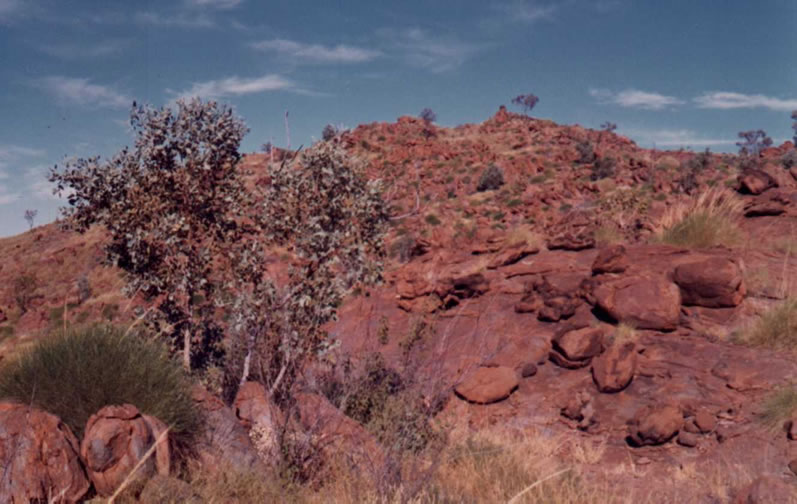 I understood shouting was useless, but I could not stop to shout
for help. Then I thought how to be recognized by the chopper. I
could make fire by burning the glass, but there was no box of match.
Unfortunately the color of my shirt was dark yellowish which was
hard to be recognized in this background. It might be good to flag
with my shirt! After a while the chopper was approaching. Hurrah....but
the chopper flew off. Shit! I repeated three times to try to send
message by flagging furiously. Never give up!
I understood shouting was useless, but I could not stop to shout
for help. Then I thought how to be recognized by the chopper. I
could make fire by burning the glass, but there was no box of match.
Unfortunately the color of my shirt was dark yellowish which was
hard to be recognized in this background. It might be good to flag
with my shirt! After a while the chopper was approaching. Hurrah....but
the chopper flew off. Shit! I repeated three times to try to send
message by flagging furiously. Never give up!
- The chopper is flying 200m above the surface at the speed of 70
- 100 km/hour. The later story clarified that it was only possible
to recognize a human being just under the focused line, worn very
distinguishable color, or in a very lucky case. The pilot Keng knew
that searching man could recognize the chopper though the pilot
could not. He could approach to the chopper by foot. Probably he
thought such scenario, and the chopper landed there. OK, OK, OK!
Wait there! I walked to the exact place where the chopper landed,
and we could meet again! After the rendezvous, I drank three cups
of water, then I began to tell the full story.
- The sunshine of midsummer here can make dried creature in a short
time. Anyway, it was a long day.
- 声を出しても届かないことはわかっていたが、それでも声を出してしまった。それから何とか連絡する方法を考えた。マッチがないので、草を燃やして煙を出すこともできない。それに今日の服装は、草の色とほとんど同じくすんだ黄色だ! それでも服を抜いてばたばたと大きく合図した。ヘリが近づいてきた。やれやれ..と思った瞬間、ヘリは飛び去っていった。やばい! 同じことを3回合図したがすべて無駄だった。だが、こんな所でくたばってたまるか!
- へりは200m位の上空を時速70~100km程度で飛ぶので、よほど真下にいるか、目立つ色か、運がいいかいずれかでないと空中から発見されることは難しいことが後になってわかった。へりからこちらを発見できなくても、こちらはヘリに気づく....そうKengさんが判断したのだろうか、へりは急に降下した。今度こそ、へりの降りた地点を見失わないように、小生がその地点まで歩いて行って、ようやくヘリと再開出来た。全く....!?1?
着くや否やまず水をコップに3杯飲んだ。皆の心配に応えるのはその後だ。
- 真夏の太陽は生き物を簡単に日干しにしてしまう。ともかく今日は長い一日だった。
> Top 7. 1000
mile linear drive - Nov. 8, 1972:
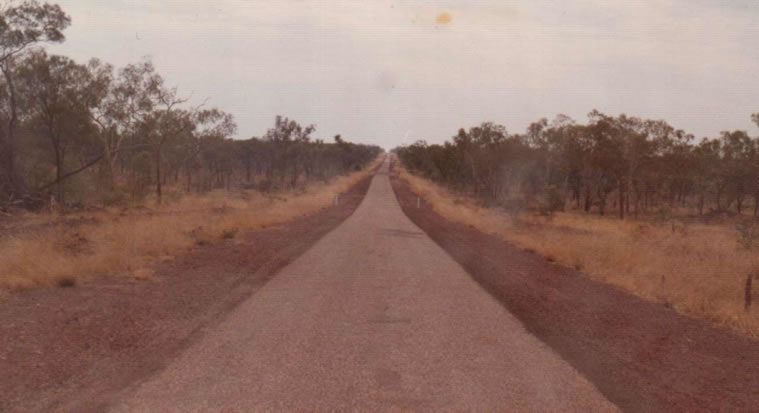 This survey season at the camp was over. During the last several
days we experienced long long drive. Following is the driving record:
This survey season at the camp was over. During the last several
days we experienced long long drive. Following is the driving record:- On Nov. 3rd around midnight we started the camp-B in Kimberley.
- On 4th around noon, we drove about 700 miles and arrived at Katherine.
- On 5th before dawn, we left Katherine and arrived the Camp-A at
McArthur River by the evening, driving about 500 miles.
- From 6th through 7th, we withdrew the Camp-A spending almost two
days.
- On 7th night, Dr. Barbieri and me left the Camp-A
for Alice Springs, center of Australia about 1,000 miles south from
here. We drove with almost no-stop except fueling the Landrover.
There were 4 or 5 oncoming cars including big land-train carrying
petroleum. Of course there was no signal. Simply asphalted road
(sealed in Australian expression) appeared horrible straight line,
continuing several hundred miles. The scene from front view and
the reflection on the back mirror are exactly same straight line.
Such crazy straight road continued for several hours.
(In Australia left side driving is normal, but in such remote areas,
we drive in the center of the road.)
We tried to sing loudly as much as possible. Dr. Barbieri is an
Italian geologist, knowing many Italian songs. I was lucky he was
an Italian, because we could sing old Italian folk songs in unison
each in Italian and in Japanese. Frequent training at singing cafe
in student times was very useful.
- On 8th 14:00, we at last arrived at 'Oasis Motel' in Alice Springs
located at the center of Australia. Before arriving here the road
where we passed continued along incredibly big boulder rock areas
after sequence of long monotonous straight line; there are just
like in Alice-in-Wonderland. We drove from last night until today
the same distance from Leningrad to London. I was surprising too
much convenience at the town compared from the camp life. The delivered
newspaper told landslide victory of Republican Nixon against Democrat
McGovern in US presidency election.
7. 1000マイルの直線ドライブ (11/8/1972):
- やっとキャンプ生活が終わった。実はここ数日、長い長いドライブの連続だった。
- 11月3日0時:KimberleyのCamp-Bを出発。
- 4日昼頃:約700マイルを連続運転してKatherineという町に着いた。
- 5日夜明け前:にKatherineを出発し、約500マイル走って、その日の夕方にMcArthur Riverに設営してあるもう1つのCamp-Aに到着。
- 6-7日と二日かけてCamp-Aの撤収作業。
- 7日夜7時:小生とDr. Barbieriの二人で遥か1000マイル南のAlice Springsへ向かった。途中でガソリン給油以外はほとんどノンストップ。途中の対向車はロードトレインと呼ばれるタンクローリー隊を含め4,5台だけだった。もちろん信号は皆無。道路は簡易舗装で、前もバックミラーに映る景色も、定規で引いたような一直線で、このような風景が何時間も続いた。
(豪州では左側通行だが、このような荒野では中央部分を走破する。)
途中、眠気をさけるために思い出すだけの歌を大声で歌いながら運転した。Barbieriはイタリア人でよかった。小生がイタリア民謡をかなり知っていたので日本語とイタリア語の合唱で大いに盛り上がった。学生のときの歌声喫茶が役に立ったよ。
- 8日午後2時:ようやく豪州の中央の町Alice Springsの"Oasis Motel"に到着した。ドライブは、直線道路のほかには信じられないような巨石群の間を通過するなど、まさに不思議の国のアリスの世界のようだった。昨晩から今日にかけて、LeningradからLondon位まで走破したことになる。いままで不自由な生活をしていたので、都会の便利さに少々驚いている状況。当地の新聞で米国大統領選挙の結果を知った。共和党のNixonが民主党のMcGovern候補に大勝したとの報道だ。
> Top 8. Staff
of AGIP Darwin office - Apr. 7, 1973:
- The second survey season started. Here in Darwin, an intense storm
and heavy rain continued about an hour this evening, thereafter
quiet night came back as usual. In tropical zone, it never drizzle,
and once it rains it becomes pouring rain, afterwards the roads
dry up immediately.
- In AGNA (Agip Nucleare Australia Pty Ltd.) in Darwin office, followings
are the members:
- Dr. Muraro: Tall and a little bit timid Italian manager.
He frequently consults with general manager in Sydney headquarter
even about minor matters.
- Mariani: Big Italian. He involved in exploration works
in African Mauritania, rather close-lipped, but speaks loudly
when exited.
- Graham: Plump Australian generalist, acts quickly,
and witty and kind.
- George: Hairy Greek. Very hairy from head to toe. Good
rival of chess for me. When I speak about history saying ancient
Greek was more intelligent than Roman, he became excited. Nice
guy.
- Edward: Englishman with beard as described in the label
of Nikka Whisky. His English pronunciation is clear and easy
to hear for me. But when he writes he sometimes mistakes in
spelling and asks me to confirm it, instead, he often refine
my English composition.
- Jack: Peruvian. He speaks freely Spanish and Italian
other than English. He likes Trio Los Panchos, and we sing together
in Spanish. Edward, Jack are working together with me from last
survey season, and are good friends, but they have weak point
of not playing chess.
- Keng: Korean pilot returned from Vietnam,
flying every day without any accident.
- Koby: Japanese. It's me. My recent reputation is improving
due to several victories in chess game. Shows gloomy by leaving
wife at Tokyo two weeks after the honeymoon trip.
- Don Wyatt: Australian geologist & site manager.
A former scholar, now began to study Japanese. A man of decent
and respectable. My wife has lodged at Mr. & Mrs. Don Whatt
during survey season.
- Other 4-5 staff: Unknown characters. They left Sydney
two weeks ago, but not yet arrived here in Darwin. We expect
their early arrival.
8. ダーウィン事務所の面々 (4/7/1973):
- 2年目の地質調査が始まった。ここダーウィンでは、今夕、激しい嵐と豪雨が約1時間続いた後、またいつものように静かな夜に戻った。熱帯の雨はしとしと降るようなことはない。降るときはどしゃぶりの雨となる。そして、その後、すぐに道路は乾いてしまう。
- 今、AGNA (Agip Nucleare Australia Pty Ltd.) にいるメンバーは
- Dr. Muraro所長:イタリア人。のっぽ。ちょっと気が弱くて、何でもSydney本社の上司に問い合わせないと心配な性分。
- Mariani:イタリア人。大男。昨年までアフリカのモーリタニアでの探鉱に参加していたとのこと。割合と無口。興奮するととたんに大声を出す。
- Graham:豪州人。ちょっとデブの事務屋。体に似合わず、機敏に行動する。ユーモアあり、親切。
- George:ギリシア人。頭のてっぺんから足のつま先まで毛深い。小生のチェスの好敵手。古代ギリシャは、ローマ人より教養があって...などと歴史の話をすると、どんどん乗ってくる。おもしろい奴。
- Edward:英国人。ひげにニッカ・ウイスキーのラベルのようななかなきいい顔してる。英語の発音は、やっぱり正確で聞きとりやすい。但し、文章を書くとき、スペルをよく間違えるので、小生にときどき聞いてくる。その代わり小生の英作文を添削してくれる。
- Jack:ペルー人。この男は、英語の他、スペイン語もイタリア語も自由に話す。トリオ・ロス・パンチョスの歌が好きで、小生とスペイン語で一緒に歌う。EdwardとJackと小生の3人は昨シーズン以来のつき合い。気のいい奴だがチェスをしないのは欠点。
- Ken:ベトナム帰りの韓国人のヘリ・パイロット。よく落ちないで毎日飛んでくれた。
- Koby:日本人。小生のこと。最近、チェスの実力を見せつけて大いに評判を上げた。新婚旅行後2週間で離ればなれになって、少々落ち込み気味。
- Don Wyatt: 豪州人Geologistのサイト・マネジャー。大学の先生もしていたという学者で、最近日本語も勉強を始めた。人間的にも素晴らしい人。
家内が、キャンプシーズン中はこのDonさん夫妻の家に下宿していた。
- その他、自動車部隊は、もう2週間も前にSydneyを出発していながら、途中のエンジントラブルなどで、まだここDarwinに到着しない4~5名がいる。早く来てくれ。
> Top 9. Constellation
in South Hemisphere - Apr. 15, 1973:
- Kimberley is the best, but even in Darwin stars shine much clearer
than in Tokyo. When we go for geological survey in remote area,
we sleep out on a portable bed and can enjoy 360 degree horizon
view. Stars and the moon look glaring over us. Someone said, 'Let's
wear a cap, or we'll be moonburnt.'
- The constellations in South Hemisphere look upside down compared
with North Hemisphere. Big Dipper looks really big near the horizon,
but the dipper is facing down and cannot ladle water. At the zenith, Spica of Virgo shines beautifully, and southeastward red
giant 0.9-magnitude bright Antales at the heart of Scorpius.
Legend says this Scorpius became a constellation in honor of its
sting on Orion, therefore Orion never appears in summer time.
- The next is Canopus of Carina which could be barely
observed near horizon in North Hemisphere. Actually I have seen
this Canopus in Australia for the first time. This is also said
as the inviting star to the south. In China this is called the Southern
Old Man Star meaning a lucky star in the south. This Canopus (-0.7
magnitude degree) and two first magnitude stars of Orion constitute
a big W character in the winter sky. This Canopus positions around
30 degrees in the north, which is the second brightest star after
Silius (-1.5 magnitude) in Southern Hemisphere.
- Southern Cross (Crux) is the most famous constellation
in Southern Hemisphere. This Crux stands erect about 25 degrees
apart from southern zenith (nadir?) in April - May season. There
is another pseudo crux bigger than the real one near the Crux. We
can distinguish that the real Crux accompanies Centarus whose α-star is the nearest to the earth (only 4.3 light years
apart), and another bright β-star. Constellations in Southern Hemisphere
are mostly named after modern machines and instruments in the Age
of Great Voyage in 17th and 18th century, which are not romantic
names. In the Crux, upper γ-star and lower α-star (0.8 magnitude)
constitute the vertical bar, and five times extension of this bar
points the Southern Zenith, while the left β-star and the right
δ-star constitute the horizontal bar, having the fifth ε-star in
the right-bellow of the center just like a mole. Only γ-star is
reddish, the other three stars are bluish white. Australian flag
designs this Crux and Centaurus α-star.
- There is Triangulum Australe,
which has an isosceles triangle in the east part of Centaurus α
and β-stars. The left apex is α-star (1.9 magnitude) which has peculiar
name of 'αTriA', meaning α Trianguli Australis.
- There is a small reverse triangle made of not more than 3rd magnitude
stars, composing a constellation called Musca, which is called
honey bee in 17th century, thereafter bee or fly, finally named
Musca (fly). I prefer to the name of bee t
 han fly.
han fly.
- Large Magellanic Cloud (LMC) together with Small Magellanic
Cloud (SMC) in Dorado are galaxies which were discovered
by Portuguese Ferdinand Magellan during his voyage. The former galaxy
is 150,000 light-year and the latter 170,000 light-year apart from
our Milky Way. These are our neighbor galaxies, constituting the
trio group of galaxies, and might collide each other in the future.
(Note: Large Magellanic Cloud becomes an index like metric system
to measure distance of the universe; the latest figure is 187,000
light years apart. If this figure increases 10%, the Hubble Constant
becomes smaller, and accordingly the age of the universe will be
elongated about 10% more. Furthermore, the above three galaxies
have the halo (inter-galaxy material) in common, and it is asserted
that these three galaxies relates positioning after the collision.)
9. 南天の星座 (4/15/1973):
- Kimberleyほどではないが、ここDarwinでも、東京とは比べものにならないほど星が輝いている。 遠くの調査に行くと簡易ベットを広げて野宿となる。まさに360度地平線だ。満天の星と月がまぶしい位だ。あまり月が明るいので「帽子をかぶって寝ようぜ。月焼けになるから...」と仲間が言っていた。
- 南半球の星座は北半球と比べて逆さまに見える。北斗七星は地平線近くに恐ろしく大きく見える。地平線近くにやっと見える北斗七星は、ひしゃくが下を向いていてとても水をすくえない形だ。天頂には乙女座のスピカが美しく輝いているし、その東南にはサソリ座(Scorpius)の
心臓部にある0.9等星の赤色巨星アンターレスが不気味に光っている。このサソリはオリオンを刺した功績で星座となったと伝えられており、このためか夏の間はオリオン座は姿を見せない。
- 次は、りゅうこつ座(Carina)のカノープス、これは関東以南で地平線すれすれに見えるというが、
(実は、小生、本物はここ豪州で初めて見たが) 南への憧れを誘う星といわれる。別名、 (中国では縁起の良い星という意味で) 南極老人星と呼ぶ。-0.7等星。オリオン座の2つの1等星などと組み合わせて冬空の大W字を構成する。南半球のここでは、北天30度位の位置に堂々と冬のこのカノープスは、シリウス
(ー1.5等星) の次に明るい恒星だ。
- 南半球の星座と言えば、やはり南十字星座(Crux)だ。丁度、今の4~5月頃、天の南極から25度位離れた所に立派な十字架が正立して輝いている。この近くに、一回り大きくて立派な「にせ十字」もある。本物と偽物の十字の区別は、本物の東側にケンタルウス座(Centaurus)にある、地球に最も近い4.3光年離れた0.1等のα星とその隣のβ星という明るい星があるのですぐわかる。南半球の星座は、あまりおもしろくない名前が多いが、17~18世紀の大航海時代に、近代的な名前をどんどん作ったことにある。南十字星は十字架の縦棒の上がγ星、下がα星(0.8等星)で、この長さを5倍延長すると天の南極を示す。十字架の横棒は左がβ星、右がδ星で、γ星だけが赤色で、残りの3つの星は青白い。なお、中心右下に十字架のほくろのようなε星がある。豪州の国旗には、この南十字の5つの星とケンタルウス座α星とがデザインされている。
- ケンタルウス座のα、βの東に、ほぼ二等辺三角形を描く星座が、南の三角座(Triangulum Australe)である。左側頂点に当たるのがα星
(1.9等星) で、南天には珍しく固有名「アトリア」がある。これはαTrianguli Australisを略した"αTriA"のこと。なーんだ。
- 南十字星のすぐ南にある3等星以下の小さな逆三角形が、はえ座(Musca)であろう。17世紀には蜜蜂と呼ばれていたが、その後、蜂または蝿となり、最後に蝿座となったという経緯がある。蜂の方がよかったのに...
- かじき座(Dorado)にある、大マゼラン雲(Large Magellanic Cloud) は、小マゼラン雲とともに、ポルトガルのマゼランが航海中に発見した。前者は15万年光年、後者は17万光年にあり、我々の隣の銀河で三連銀河構成している。そのうちお互いに衝突するかも知れない。
(後注:大マゼラン雲は、宇宙の距離を測るときのメートル原器にような指標となっており、その距離は現在では18.7万光年とのこと。この値が10%大きくなると、ハッブル定数が小さくなり、宇宙の年齢が約10%大きくなるとのこと。更に、三連銀河はハローを共有しており、すでに衝突した後との説もあるらしい。)
> Top 10. Radio communication - May 18, 1973:
- A letter from Tokyo dated 10th arrived here in Halls Creek spending
one week. Australia is so spacious that such services as mail or
medical service depend on air flight connecting remote areas like
famous 'Flying doctor.'
- Our camp could have a facility of radio communication, and succeeded
to contact with Kununura, which will be very useful for urgent communication
and gives us a sense of security that we are no more isolated here.
This radio facility can communicate with a place 200 miles away,
but it is really difficult for a non-native speaker to communicate
in English. The opposite native speaker can recognize my English,
but I cannot recognize faint meaning words from noise. There is
a big difference in hearing ability in recognizing words between
native speaker and non-native speaker. Australian or Englishman
can pick up meaningful words from careful listening to the speaker,
spending several seconds of concentration for recognition. Native
speakers have very trained and sensitive brain process in recognition
of their mother tongue.
- One point lesson of Aussie English:
- For my ear every character is pronounced in Aussie English,
for example, Monday sounds 'Mon-dai', Good day 'Good-dai', Taken 'Taa-ken', Often 'Off-tn', Gate 'Gai-t'.
Australians' favorite term Mate sounds 'Mai-t'. Eight sounds 'Ai-t'. So Gate-8 sounds to me like 'Gai-t Ai-t'.
- When I show spelling A-character sounds 'Ai', therefore
when I spell KOBAYASHI which will be misspelt like KOBAYASHA.
When I first come to Australia, I misunderstood the pronunciation
of 'See you later' like 'See your lighter', so I replied
'Sorry I don't smoke. I don't have any lighter.'
- The comparative expression in Australia to express temperature
over 40 degrees Celsius (104 F) will be described (only in the
camp!) as 'hot, hotter, hottest, bloody hot, fucken hot.'
10. 無線通信 (5/18/1973):
- 日本からの10日付の手紙が1週間かかって、ここHalls Creekに到着した。豪州は広いので、郵便とか医者(Flying
doctor) は小型飛行機で陸の孤島のような待ちを結んでいる。
- 我々のキャンプにもついに無線通信設備ができて、Kununuraと交信に成功した。今後は、緊急連絡用に役立つ。それに自分たちは孤立していないという安心感が大きい。この無線設備は200マイルも離れた所と交信可能とのことだが、やはりNon-Englishには難しい。相手は、こちらの英語はわかるが、こちらは相手の英語が聞き取れないのだ。この時は、ネイティブとのヒアリング能力の差を実感した。豪州・英国人は、雑音としか聞き取れない音の中から、耳をスピーカにつけて、しばらく考えた後、言葉の音を拾い出すことができるのだ。自国語に対しては、全く感度の違う耳というか大脳処理力を持っているのだ。くやしいけど....
- 豪州英語のワンポイント・レッスン:
- 中学時代に英語のスペルを覚えるためにそのまま文字通りに読むと豪州英語らしくなるようだ。
- "Monday"はマンダイ、"Good day" はグダイ"taken
はターケン、"often" はオフトゥン、"Gate" はガイト、豪州人が親しみをこめて多用するMate
はマイト、"Eight" はアイトのように聞こえる。8番ゲートはガイト・アイトとなる。
Aの文字はアイに聞こえる。コバヤシのスペルの最後を、エス・エイチ・ アイというと、"SHA" とされてしまう。 シー・ユー・ライターに対し、小生タバコ吸わないからライターもってないよと答えてしまったが、"See
you later" だったのか!
- 英語の話の続きだが、40度を超える猛暑をいまいましく表現するには、最上級では足りないようだ。hot, hotter,
hottest, bloody hot, fucken hotとオーバーに言わないと...
> Top 11. Pre-Cambrian
Rocks - May 24, 1973:
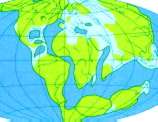 It is getting cooler here in Kimberley,
and even cold particular in early morning and evening.
It is getting cooler here in Kimberley,
and even cold particular in early morning and evening.
- Metamorphic rocks are widely distributed around the camping area,
which are the oldest rock crystallized about 2 billion years ago
(Pre-Cambrian age), never found in Japan. They are hardly weathered
rocks, and the description of difference is rather difficult. It
is surprising that rocks derived from glacier period are found here;
Australian continent was once attached to the Antarctic continent
at Eocene of Tertiary period (58 - 36 million years ago), drifting
to the present location spending long times.
11.先カンブリア紀の岩石 (5/24/1973):
- 朝晩は、ここKimberleyも涼しく、時々寒くなった。
- 今いるキャンプ付近には変成岩が広く分布していて、しかも日本には見られない20億年位前の先カンブリア紀の岩石が多く、違いを記載するのに苦労している。それに何と氷河時代の後に出来る岩石も分布している。大昔、新生代第三紀始新世
(58 - 35百万年前) 、豪州大陸は南極大陸とくっついていて、大陸移動して現在の位置に来たということなのだ!
> Top 12. Unique
Australian Fauna & Flora - June 21, 1973:
- I went for a
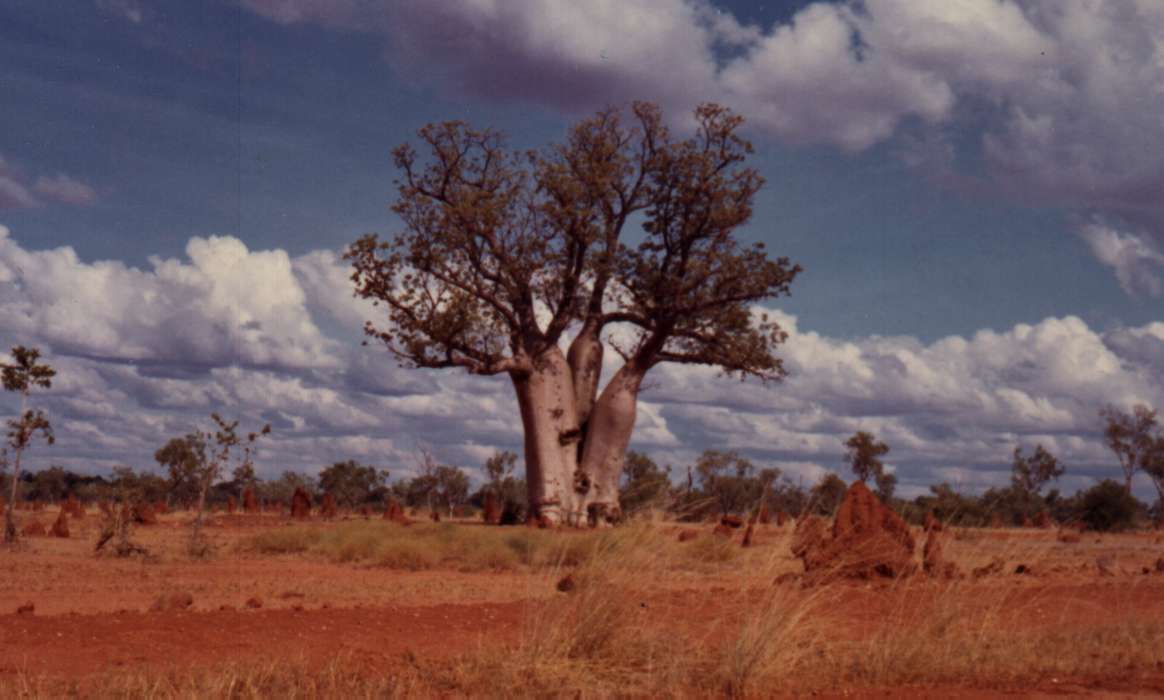 drive to Casuarina Beach,
north of Darwin by Land Rover, and watched alone the flaming sunset
into the sea. The seashore was partly occupied by sporadic young
motorcycle trainees. The sunset changed its color of gradation
from orange, yellow, pinkish, purple and blue.
drive to Casuarina Beach,
north of Darwin by Land Rover, and watched alone the flaming sunset
into the sea. The seashore was partly occupied by sporadic young
motorcycle trainees. The sunset changed its color of gradation
from orange, yellow, pinkish, purple and blue.
- There is a windmill near the camp, which creaks like pedaling
a bicycle in windy days. After the stop of electric generator in
the camp, all the noise comes from this windmill.
- Eucalypt and Baobab (Boab Tree) are typical trees
in the arid region. Boab Tree is said to swell water in its truck.
Eucalypt tree in Kimberley becomes lean, probably due to lack of
water, which makes insufficient shade area for us.
- Spinifex is a spiny grass growing almost everywhere in
Kimberley. Our survey style is usually half pants and long socks,
which cannot avoid painful pricks of the spiny grass. Spinifex looks
mostly withered up in dry season but can survive until the next
rainfall.
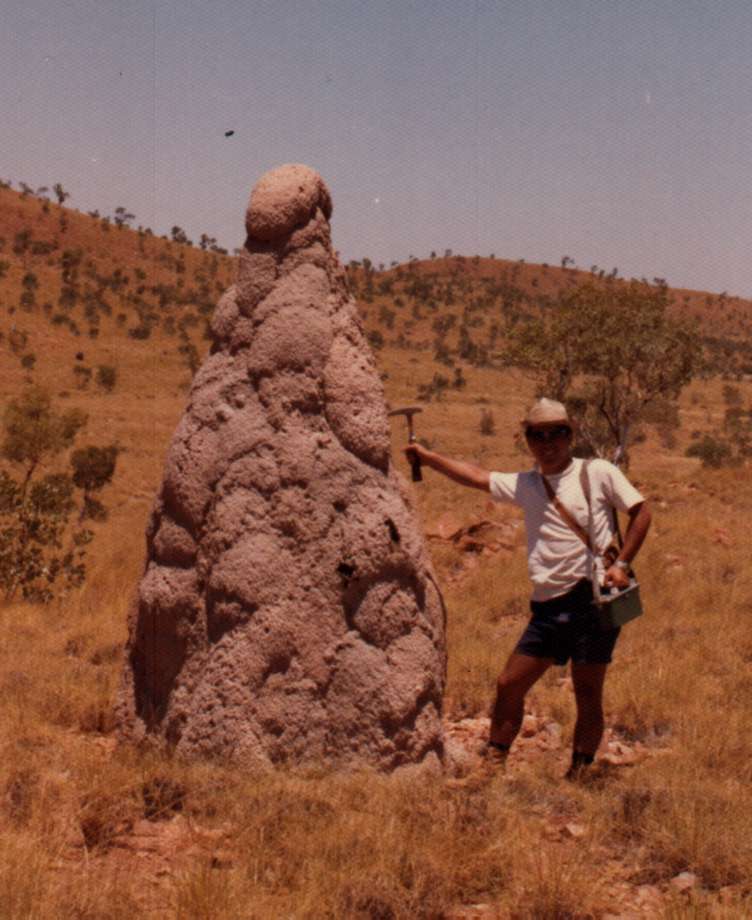 Great Anthills scatter here and there, but the ant itself
is normal in size, reddish brown with pale greenish around waist.
We can kick down smaller anthill, but furiously angry ants rush
at us. Giant sized anthill is a big lump of clay (of course with
no reinforcing bar) which is almost shock-resistant even hit by
a car. There are many cavities for comfortable residence inside
of an anthill to avoid outside heat wave.
Great Anthills scatter here and there, but the ant itself
is normal in size, reddish brown with pale greenish around waist.
We can kick down smaller anthill, but furiously angry ants rush
at us. Giant sized anthill is a big lump of clay (of course with
no reinforcing bar) which is almost shock-resistant even hit by
a car. There are many cavities for comfortable residence inside
of an anthill to avoid outside heat wave.
- In the end of rainy season, abnormal breeding of locusts happens; when we drove Rand Rover, we encountered swarm of locusts,
which looked like sand storm. We rushed by car clashing locusts
by saving net over the radiator. Locusts collided the front window,
which were wiped off remaining sticky oil one after another. We
felt we were happy staying inside the car.
- One day, our car collided at a log; which was not a log but a
big Goanna over one meter in size. Goanna must have been
damaged also.
- Frilled Neck Lizard once became popular in Japanese CM
film, but this is not so well-known lizard in Kimberley.
- We met Dingo in the bush, which is a kind of wild carnivorous
dog and is said to attack without barking. But we stared each other,
then separated.
- A gigantic Praying Mantis is slowly wandering about near
my tent, who is more than 30 cm in the size with bright light green
color. Insects living in Australia are mostly big and fearless.
- We are annoyed by billions of flies clinging to us in the
face, arms and legs in the bush areas. Whenever we take lunch outside,
we must be mostly careful about not to swallow flies clinging to
sandwiches. The taste of a fly..... I don't want to describe it!
Oh, retch!
- The main cast of the daytime is flies, while that of nighttime
is mosquitoes. Our tent is structured like a mosquito net
which requires careful comings and goings. When we find a mosquito
invader, the cleaning up battle becomes the top priority.
- Redback Spider with a grip size sometimes appears in the
tent and causes us panic.
- King Brown Snake is also a big snake and wanders about
by its pace, unhurriedly observes us and leaves away.
- Barramundi, a kind of Australian bass. Many freshwater
fishes are called Barramundi here, just like we call only cow without
distinguishing kinds of cows.
- Crocodile, a smaller in size. There are
lots of explanation about the difference of crocodile and alligator.
Someone says there is no alligator in Australia, but there is a
river named South Alligator River in NT. The other simply calls
a bigger crocodile an alligator.
- Wallaby is a small kangaroo, who is pale in color. We can
encounter a red brownish big Kangaroo, who is nocturnal animal
and sometimes jumps into a moving car. Once when we drove a car
in the nighttime, a big kangaroo
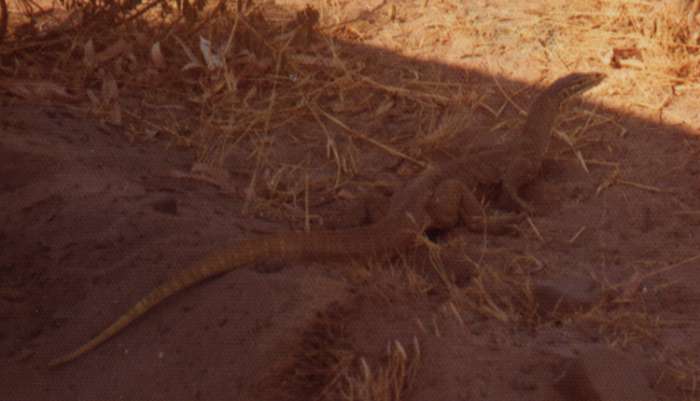 suddenly jumped in the light, and
one of light of the car was broken. Nighttime driving in the wasteland
needs to be equipped additional stronger bumper named 'Kangaroo
bumper.'
suddenly jumped in the light, and
one of light of the car was broken. Nighttime driving in the wasteland
needs to be equipped additional stronger bumper named 'Kangaroo
bumper.'
- Emu is the biggest bird in Australia. Once an emu competes
our car in running and hits in the door. The Australian emblem is
a kangaroo and an emu.
- Jabiru is Australian stork, having white head, black tail,
and red legs. Jabiru is a monumental species and rare to be found.
- Kookaburra is a nosy bird with big dark brown head and
white belly. But northern kookaburra twitters not so loudly.
- Jumbuck is Australian sheep. When we see a herd of jumbucks
from an airplane, they look like lice on the ground.
- Fox bat (Flying fox) is a kind of Australian large-sized
bat, usually living in rocky area, and begins to fly around in the
evening.
12.豪州の自然あれこれ (6/21/1973):
- Darwin北方にあるCasuarina Beachへ、Land Roverで一人ドライブした。海に簿する真っ赤な日没を堪能した。海岸には人の姿はまばらで、若者達のバイクの競技場となっている。
夕焼けは橙、黄、ピンク、紫、青とグラデーションの光景が見られる。
- キャンプの近くにWindmill風車がある。風のある日にはカランコロンと自転車を漕いでいるような音がする。自家発電機が止まるとこのWindmillだけの音の世界となる。
- Eucalypt ユーカリと Baobab (Boab Tree) は乾燥に強い植物。Boab
Treeは幹が膨らんでその部分に水分を貯めるという。キンバレーのユーカリは暑さのせいか、やせこけており日陰としてもあまり役に立たない。
- Spinifex 至る所に散在している針のような尖った葉をもつ草。野外調査は半ズボンにロングソックスという服装なので、どうしても脚に部分によく刺さって、実に痛い。乾期にはほとんど枯れたような状態になるが、じぶとく乾燥地帯で生き延びている。
- 巨大なアリ塚 Anthill:アリ自体は巨大ではなく、赤茶に腰の辺りが薄緑色の普通のアリだが、巨大なアリ塚を作る。小さい物なら蹴飛ばせば倒れるが、アリが怒って飛び出し襲ってくる。デカイアリ塚は自動車でも衝撃がある位の土の塊となる。(どんなにデカくても鉄筋などは入っていない!)
内部は細かな空洞が沢山あり、猛暑を防ぐ快適なすみかとなっているようだ。
- 雨期の終わりのシーズン頃、Locust イナゴの大発生する時期がある。Rand Roverで移動中に遭遇したことがある。砂嵐のように見えなくなり、防御ネットでラジエーターを保護しながら、イナゴの大群の中を突進した。ウインドウに次々と激突して、ワイパーでこすられ一面イナゴの油まみれになる。車の中にいて本当に助かったと思った。
- ある日、車の運転中に丸太にぶつかったような衝撃があった。見たら1mを超す大トカゲのGoannaだ。相手も痛かったろうに..
- Frilled Neck Lizard、以前日本のCMで有名になったエリマキトカゲのこと、当時はそんなに有名ではなかった。
- 豪州で野犬化した肉食のDingoに会った。Dingoはほえないで襲うと言われるが、互いににらみ会って別れた。
- とにかくデカいPraying Mantis カマキリがテントの近くをゆっくり徘徊していた。30cm以上はあったと思う。鮮やかな緑色をして怖いくらいだ。この豪州ではとにかく昆虫が大きくて大胆不敵に生活しているみたいだ。
- Fly ハエ...とにかく多いし、まとわりついてくるのでかなわない。野外でサンドイッチを頬張る時などよく注意しないとハエも一緒に飲み込むはめになる。それ以上は語りたくない...ゲ--
- 昼の主役が ハエなら、夜の主役はMosquito 蚊だ。テント全体が蚊帳のようになっているので出入りには注意が必要。蚊が侵入すると、何よりも優先して蚊退治から始めなければならない。
- Redback Spider このヒメグモはときどきいて、こぶし位のデカい毒蜘蛛がテントに侵入してくることがある。テントはパニック状態になる。
- King Brown Snake という大きなヘビも、それほどいないが、出会うとやたらとデカいなかなか逃げない。相手も人間を観察しているようだ。
- Barramundi。豪州産のスズキの一種らしいが、淡水魚は何でもBarramundiといっているみたい。我々が、牛というのと同じだ。
- クロコダイル Crocodile。やや小型のワニ。Alligatorとどう違うのかについては諸説ありわからない。そもそも豪州にはAlligatorはいないという説もあるが、NT準州には、South
Alligator Riverという名の川があるし、単に大型のワニをAlligatorと呼ぶこともある。
- ワラビー Wallaby。小型のKangarooで、色も薄い。大型の赤茶色のKangarooもたまに見かける。夜行性とのことで夜間の走っている車にジャンプしてぶつかってくることがある。小生も一度、休暇中にぶつけられ、車のライト片方を失った。豪州の車にはKangaroo
bumperがないと野外走行は危険だ。
- 豪州原産の最大鳥のEmuも、車と競争して横のドアにぶつかってきた。豪州の紋章はカンガルーとこのエミュ-だ。
- Jabiruは、豪州原産のコウノノリStork。体は白く頭と尾の部分が黒く足は赤い。Jabiruは天然記念物的存在でなかなか見られない。
- Kookaburra 頭のデカい焦げ茶色で腹部が白いワライカワセミのこと。けったたましい笑い声のように鳴くというが、北部のはあまり鳴かないらしい。
- Jumbuck 豪州の羊。小型の飛行機から見ると白いウジの群のように見える。
- Fox bat (Flying fox)。木の多い岩山にいて夕方になると飛び出す豪州のおおこうもり。
> Top 13. Chess
champion defeats - June 23, 1973:
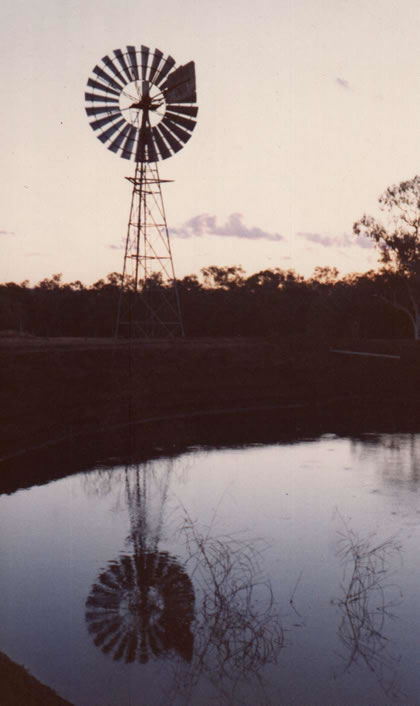 The chess champion in our camp is Mr. Antonio Buzatic (called
Tony), the only cook from Poland. The battle chess game continued
this night challenging to him. I also dared him, in spite of almost
50 defeats with only exceptional win. Other men's challenge brought
similar result. Edward, an Englishman, won once, but all other games
ended as Tony's victories.
The chess champion in our camp is Mr. Antonio Buzatic (called
Tony), the only cook from Poland. The battle chess game continued
this night challenging to him. I also dared him, in spite of almost
50 defeats with only exceptional win. Other men's challenge brought
similar result. Edward, an Englishman, won once, but all other games
ended as Tony's victories.
- I had spent very busy week to attend the mission from Japan, which
brought change of my life rhythm to some extent. I was reluctant
in challenging chess game this evening. Tony put forward his pieces
with confidence as usual, while I only followed his pace. After
about an hour of process, I could understand the opponent queen's
movement looked dull than usual. Our pieces rushed to his camp,
getting a slight better position there. Forty minutes passed. I
WON at last, which became my second glorious victory over him. Surrounded
observers including camp manager clapped and offered their hands
to me.
- Tony, after unexpected defeat of the game, said a lower voice
"One more, Koby!" The second match started. The outside
is calm pitch dark night, and the waning moon was rising soon eastward.
Songs of insects were penetrating us. Considering the phrase of
'accidental wins never continue', I only proceeded my pieces nonchalantly
without believing further miracle. (In Japanese proverb, 'There
is no second loach under the same willow.') Best trial and decent
defeat was the only possible scenario. I felt my pieces getting
smaller on the board. Then about an hour passed.
- The situation surpassed my expectation. I looked Tony in his
face. I had never seen such a serious face of him. He said he has
thirty years career in chess match, and the game of tonight would
be remembered for a long time. Another half an hour passed. Each
step seesawed between life and death of the match. The number of
remained pieces are almost equal, but my position looked slightly
favorable. I could proceed my pieces according to natural flow without
thinking of my win all the time. Another miracle happened. I WON
AGAIN. I won two consecutive games tonight.
- He was too strong in chess game in the camp. He is always preparing
all foods for ten of camp staff, and whenever he plays it always
finished with his winning game. But tonight his back view saying
'Good night. See you tomorrow morning' looked happier to find a
valuable competitor. I heaved a sigh and imagined the next night's
miserable defeat.
13.チェスチャンピン連敗す (6.23/1973):
- 我がキャンプの無敵のチェスチャンピオンでユーゴ出身の巨漢のコックMr. Antonio Buzatic (Tonyと呼んでいるが)
との激烈なチェスの死闘が昨夜も続けられた。彼との対戦成績は1勝50敗位で小生が圧倒的に負けている。他の連中もそれぞれAntonio氏に挑戦するが、わずかにEdwardという英国人だけが1勝をあげたのみ。後はすべて数十連敗しているはず。
- 小生、このところ日本からのミッションが来たりして、生活のペースが若干ずれていたので、この晩もなんとなく初めから乗り気がしなかった。余裕しゃくしゃくと駒を進めるTonyに比べ、当方の駒はまるでつき合いで進めているようなもの。試合開始後約1時間、重要な対局場面で相手のQueenの動きにやや悪手が見えた。ソレーッとばかり必死に突っ込む我が陣営。それから40分、ついに勝利。小生にとって通算2勝目の金星を挙げた。傍らで観戦していたキャンプ・マネジャーも大きな拍手と握手攻め。
- 一敗地にまみれた後、チャンピオンの面目にかけても一晩2敗はなるものかと、"One more, Koby!"と低い声。第2戦が始まった。外は静かな真っ暗闇。そろそろ下弦の月が東の空に昇る頃。虫の声はしみとおるようだ。「柳の下にどじょう2匹はいない」と思いつつ、2戦目は、もはや奇跡を信じず淡々と勝負することにした。精一杯闘って美しく敗れ去ろう。当方の駒がなぜが一つ一つ小さくなっているような気がした。そして1時間余り...
- 形勢は悪くない。Tonyの顔を見る。こんな真剣な顔つきは見たことがない。チェスを始めて30年というが、今夜の一戦はきっと覚えていてくれるかも知れない。再び30分経過。一歩一歩を争う死闘となった。駒数はほとんど同じ。位置は当方がやや有利と見た。こちらは初めから勝てるとは思っていなかった。無心無欲の自然流で美しく敗れることのみを考えていた。そして再び奇跡が起こった。小生が勝ったのである。一晩に連勝したのだ。
- 今まで彼は強すぎた。朝から晩まで10人もの男たちの口のことを心配しているコックの彼は、闘えば必ず勝つチェスは、きっとおもしろくなかったのだろう。頭を叩きながら"Good
night. See you tomorrow morning."と言いつつ去っていく彼の後ろ姿は、なぜかとてもうれしそうだった。勝った小生の方が、逆に大きなため息。「あーあ、明日の晩は徹底的にやっつけられるだろうな ...」
> Top 14. Hope
from Tokyo - Aug. 9, 1973:
- I am considering how to spend after the camp season, for this
bonus I can endure any hardship at the camp. In August glaring sun
returns in Kimberley area. Geological survey activities continue
with sampling by hammer and measuring gamma ray by scintillation
counter, sometimes murmuring 'Burn you!'
- Since last May, three men left from the camp due to irresistibly
monotonous life, and another one is scheduled to come back after
his vacation, but not yet. If only money is concerned, I will say
goodbye from here even tomorrow, but I can't because of my honor
and expectation. I remember once you marked on the column of Shosha-man
with double circle, commenting 'Chizu's hope.'
14.商社マンへの期待 (8/9/1973) :
- 調査シーズン終了後の計画は着々進んでいる。今の厳しい生活もその楽しみがあるからやっていけるようなものだ。Kimberleyも8月中旬ともなると早くも強烈な太陽の光が戻ってくる。時々「こんちくしょう」と思いながら、ハンマーを振ったり、シンチレーションカウンターでガンマー線を測定したりしている。
- もう5月のキャンプ以来、3人も単調な生活に耐えられなくなってキャンプを去っていった。もう一人、休暇が終わっているはずなのに戻ってこない奴もいる。
(キャンプは5週間連続の調査の後、1週間の休暇となる。) 小生だって、お金のためだけだったら明日にでもグッドバイする。しかし、どんなにつらくても今は脱出できない。名誉と期待が懸かっているいるからだ。以前、「千津の期待」と書き込んで、商社マンの職業に◎をつけてくれたことを思い出した。
> Top 15. Rainy
season comes - Aug 28, 1973:
-
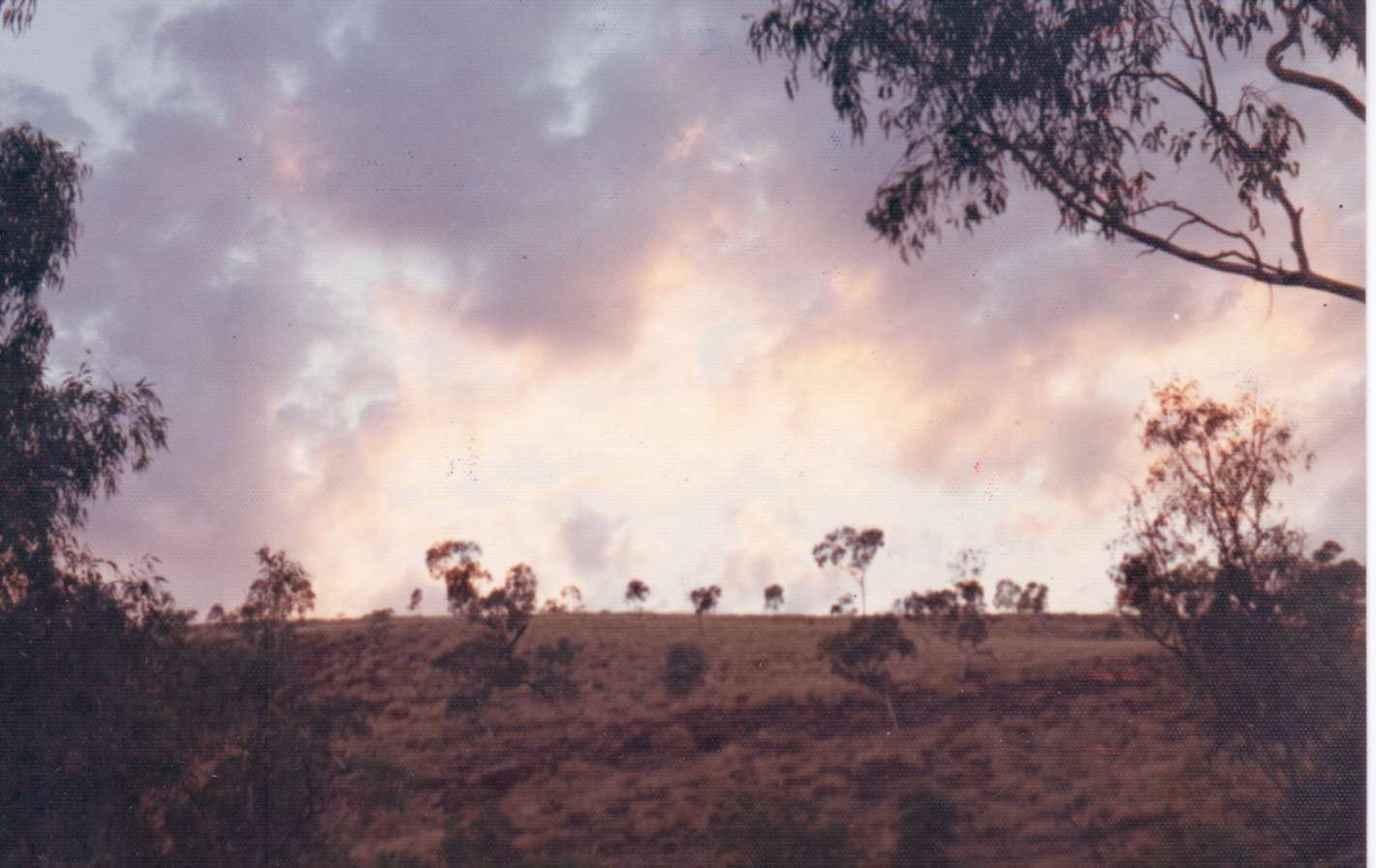 Here in Kimberley area, heavy rain continued for two days from
Aug. 25. I was first to look at such a heavy rainfall at the desert.
As the surface was completely dried up, water pond was believed
to dry soon after rainfall, but the following day someone outside
shouted 'Flood came!.' When I jumped out to see it, wide dry sand
covered river (Wadi) suddenly became turbid current and increased
its volume of water. The flood ran rapidly because of less vegetation
there.
Here in Kimberley area, heavy rain continued for two days from
Aug. 25. I was first to look at such a heavy rainfall at the desert.
As the surface was completely dried up, water pond was believed
to dry soon after rainfall, but the following day someone outside
shouted 'Flood came!.' When I jumped out to see it, wide dry sand
covered river (Wadi) suddenly became turbid current and increased
its volume of water. The flood ran rapidly because of less vegetation
there.
- Since yesterday night, enormous amount of frogs suddenly
appeared which we never seen before. They are singing endless like
'Kimberley Dessert Chorus' tonight. Such turbid current will be
put down in a couple of days, but we must keep severe water conservation
for a while; no shower and no washing but drinking water.
15.いよいよ雨期到来! (8/28/1973):
- いよいよKimberley地域に3日前の25日から2日間大雨が降った。砂漠の大雨を見たのは初めてだ。地面が乾き切っていたので、雨がやんだら水たまりもなくなると思っていたら、その翌日、誰かが大声で「洪水だ」と叫んだ。あわてて外に出ると、いままで砂ばかりの広い川(Wadi)があっという間に濁流となりどんどん水量が増していく。木が少ないので一気に洪水となって流れていくのだ。
- 昨晩から、いままでまったく見えなかった蛙が大発生した。今晩もひっきりなしに「キンバレー砂漠男性合唱団」をやっている。2ー3日で濁流はなくなると思うが、それまで厳しい節水令が出た。飲み水以外は、シャワーも洗濯も禁止となった。
> Top 16. Three more weeks - Oct. 14, 1973:
- Geological survey of this season terminates in about three weeks,
depending on the arrival of rainy season. Then withdrawing of the
camp starts within one more week. We can leave here around Nov 10
and return to the civilized area.
16.調査シーズンあと3週間 (10/14/1973:
- 雨期の到来時期にもよるが、いよいよ今シーズンの調査はあと3週間位で終了することになった。その後1週間でキャンプを閉鎖して移動作戦開始だ。おそらく11月10日頃になりそう。さあ、文明への復帰だ。
Comment
- Where have gone all colleagues and friends at Kimberley Camp?
Don, Ed, Jack, George, Tony, Keng, Muraro, Graham, Mariani, Barbieli,
Giovanelli,.... Cop you later mates!
- Our human memories are too short compared with long memories carved
in the PreCambrian rocks there!
- キンバレーのキャンプの仲間や友達は皆どこへ行ってしまったのか?ドン、エド、ジャック、ジョージ、トニー、ケン、ムラーロ、グラハム、マリアーニ、ジョバネリ... さよなら。
- あそこの先カンブリア紀の岩石に刻まれた長い記憶に比べれば、我々人間の記憶はあまりにも短い。
 |
Bush Life in Kimberley, WAUranium exploration camp in 1972-73 |
Cat: MIS
|
Kanzo
Kobayashi |
90131u/18206r |
Summary |
要約 |
 |
|
0. Australia - 1972:
|
0. Australia -1972:
|
>Top 1. Joint uranium exploration works in Australia:
|
1. 豪州ウラン共同探鉱に従事:
|
>Top 2. Camp at Kimberley - Sept. 26, 1972:
|
2. キンバレーのキャンプへ (7/26/1972)
|
>Top 3. Halls Creek: population of 200 - Oct. 11, 1972:
|
3. 人口200人のHalls Creek (10/11/1972):
|
>Top 4. Holidays at the camp - Oct. 12, 1972:
|
4. キャンプの休日 (10/12/1972) :
|
>Top 5. On the billabong - Oct. 14, 1972:
|
5. ビラボンのほとり (10/14/1972):
|
|
|
> Top 6. I missed the Chopper! - Oct. 16, 1972:
|
6. ヘリコプターがいない (10/16/1972):
|
|
|
> Top 7. 1000 mile linear drive - Nov. 8, 1972:
|
7. 1000マイルの直線ドライブ (11/8/1972):
|
> Top 8. Staff of AGIP Darwin office - Apr. 7, 1973:
|
8. ダーウィン事務所の面々 (4/7/1973):
|
> Top 9. Constellation in South Hemisphere - Apr. 15, 1973:
|
9. 南天の星座 (4/15/1973):
|
> Top 10. Radio communication - May 18, 1973:
|
10. 無線通信 (5/18/1973):
|
> Top 11. Pre-Cambrian Rocks - May 24, 1973:
|
11.先カンブリア紀の岩石 (5/24/1973):
|
> Top 12. Unique Australian Fauna & Flora - June 21, 1973:
|
12.豪州の自然あれこれ (6/21/1973):
|
> Top 13. Chess champion defeats - June 23, 1973:
|
13.チェスチャンピン連敗す (6.23/1973):
|
> Top 14. Hope from Tokyo - Aug. 9, 1973:
|
14.商社マンへの期待 (8/9/1973) :
|
> Top 15. Rainy season comes - Aug 28, 1973:
|
15.いよいよ雨期到来! (8/28/1973):
|
> Top 16. Three more weeks - Oct. 14, 1973:
|
16.調査シーズンあと3週間 (10/14/1973:
|
Comment |
|
|
 Attention: my fiancee
Attention: my fiancee